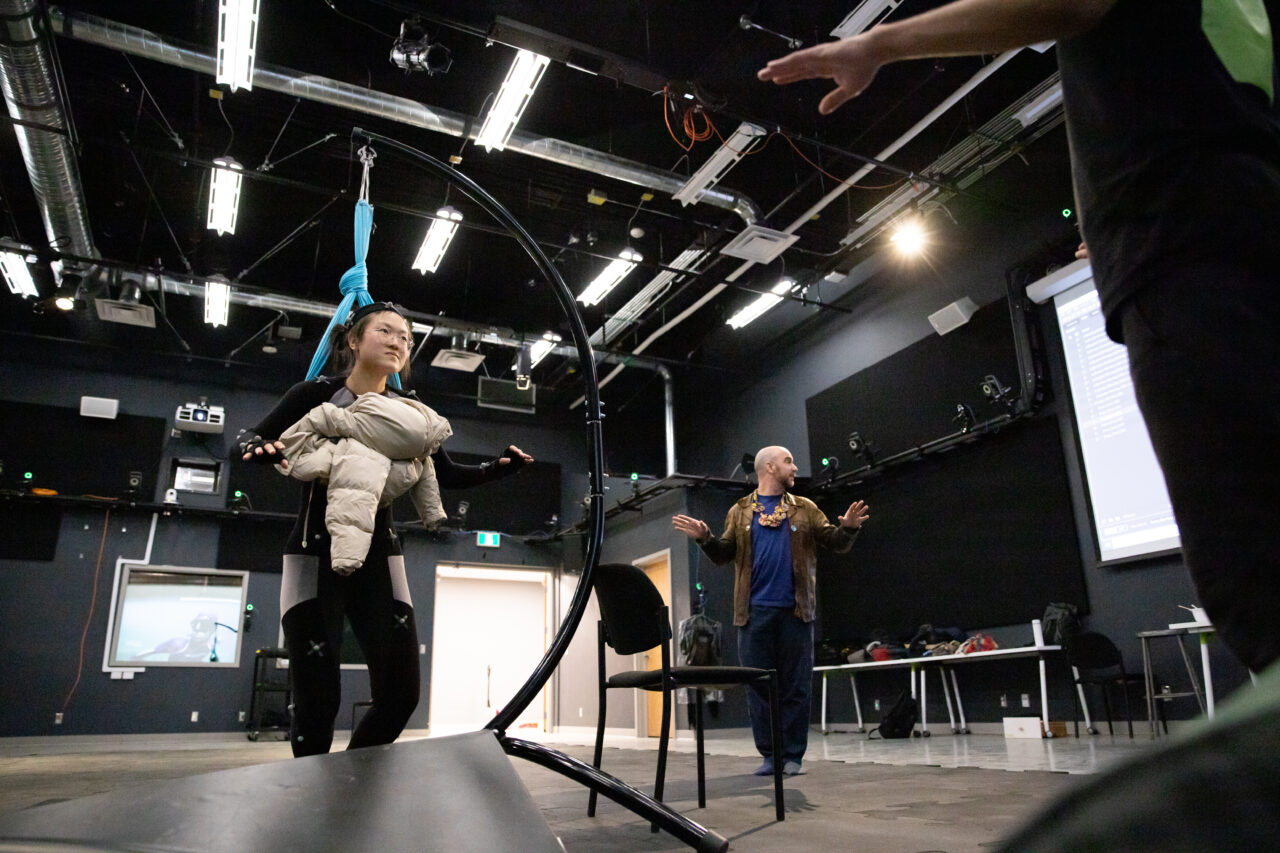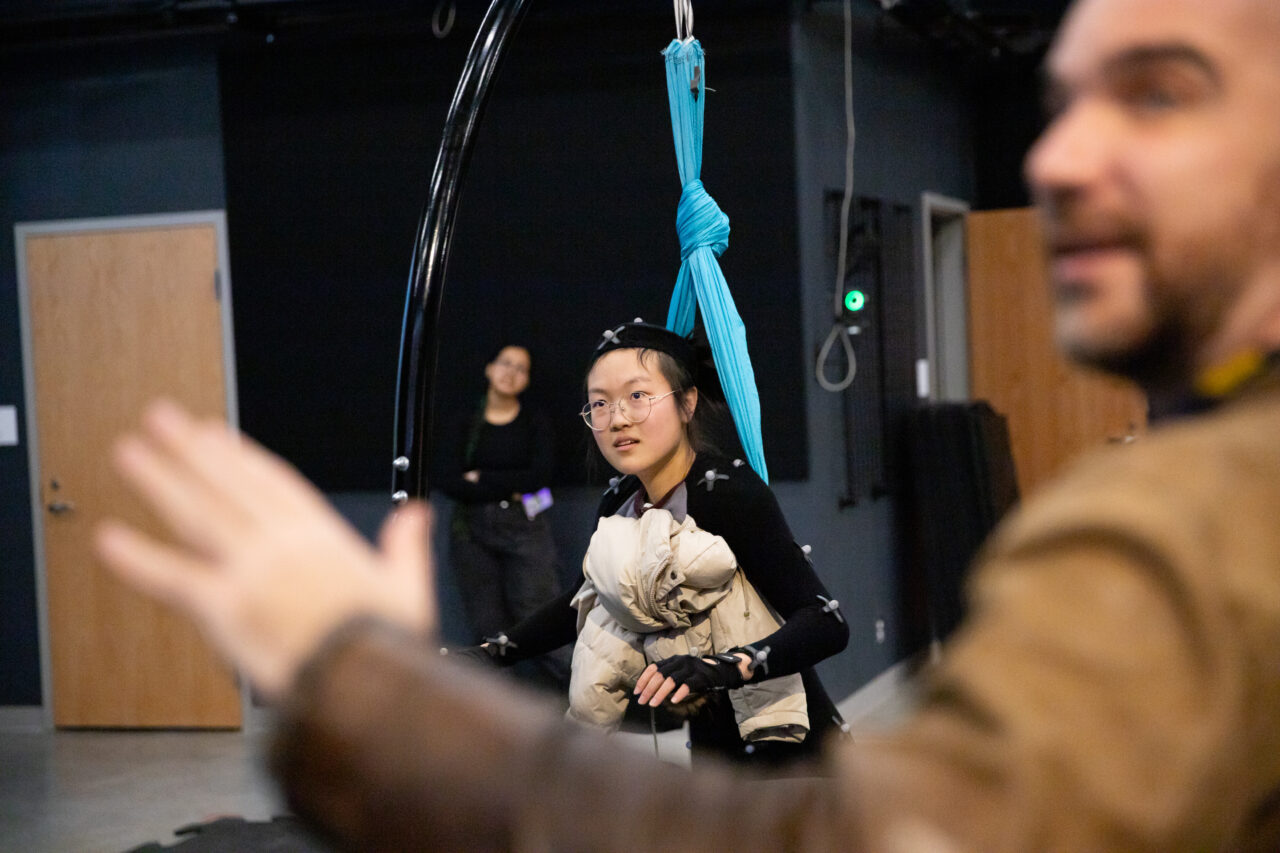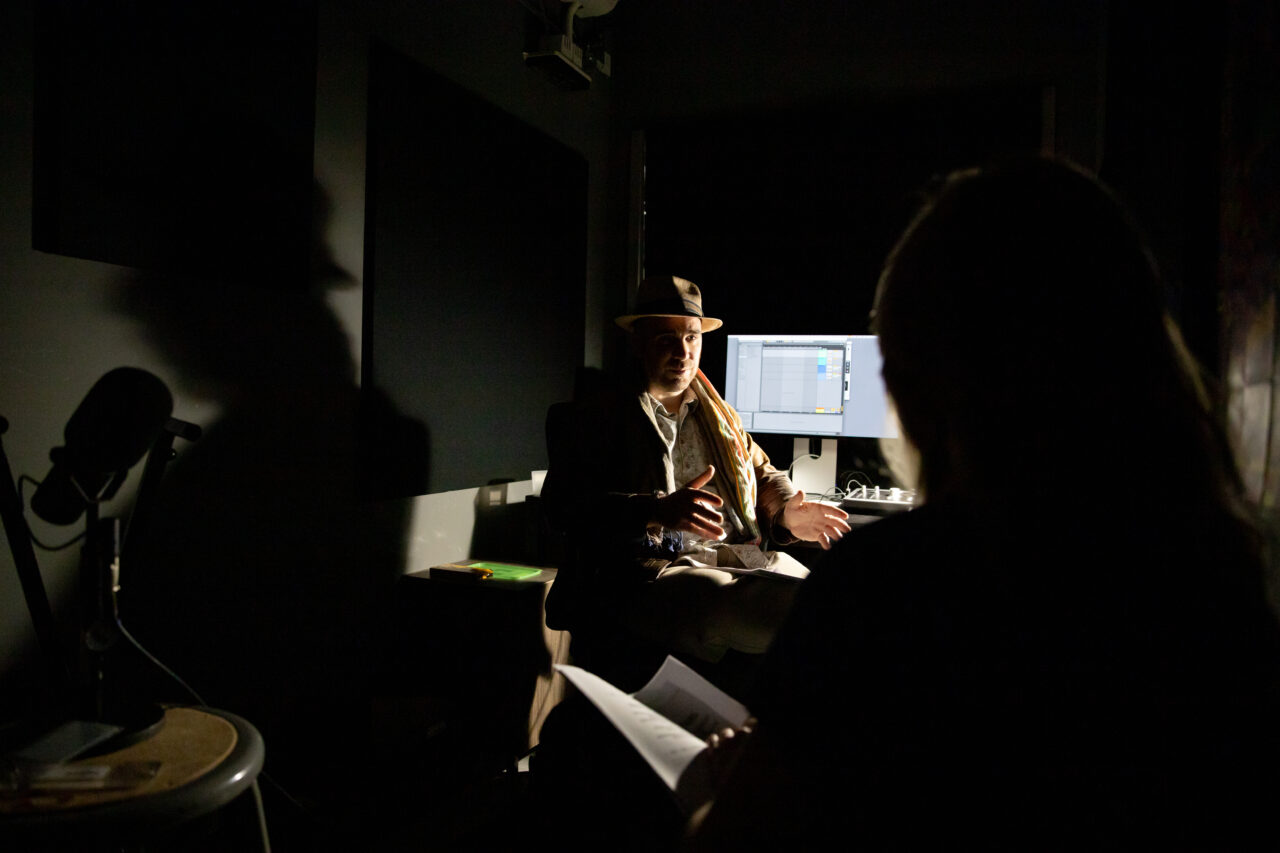Pierre ‘Pyaré’ Friquet Brings Immersive Aquatic Narrative Adventure to Research Residency at ECU

Wearing a motion-capture suit, 2D + Experimental Animation student Chengxi “Jaycie” Zheng mimics walking along the seafloor under direction from Pyaré (left) and with assistance from Master of Design student Asad Aftab (right) in the Integrated Motion (MoCap) Studio at ECU. (Photo by Perrin Grauer)
Posted on
The Paris-based digital artist has been working with students, staff and faculty at the Basically Good Media Lab on his newest VR project throughout November.
Paris-based digital artist Pierre “Pyaré” Friquet has been working with students, staff and faculty on his latest virtual reality (VR) video experience, Captain Nemo, as part of a residency at the Basically Good Media Lab (BGML) at Emily Carr University of Art + Design (ECU).
Pyaré says his time at ECU has given him access not only to technology and expertise but also to a level of postcolonial discourse that has yet to permeate many mainstream European cultures.
“I’m learning and getting education from everyone, honestly,” he says. “It’s great to be in this place for the first time. Lots of inspiration, great resources, great vibe in general. I feel very much at home.”

Captain Nemo rendering by Pierre Friquet. (Courtesy Pierre Friquet)
Now in its third year of development, Captain Nemo will see players make allies with marine creatures, pilot an underwater submersible, explore sunken worlds and battle British forces, all set against the historical backdrop of the Sepoy revolt. Also known as the Indian Mutiny of 1857, the Sepoy Revolt was a 19th-century rebellion against British rule in India.
The narrative draws on themes that appear throughout Pyaré’s oeuvre including decolonization, environmental awareness and technological symbiosis. The game is also compatible with a cutting-edge immersive diving mask designed by Pyaré, which enables VR experiences in aquatic settings.
Pyaré connected with the BGML with support from the Consulate General of France, which aims to create connections between creative communities in France and abroad.

Pierre Friquet's NiGHT immersive diving mask. (Photos courtesy Pierre Friquet)
Artist, ECU faculty member and BGML co-director Julie Andreyev says his residency helps connect the ECU research community with local and international organizations and networks.
“The BGML is thrilled to be hosting Pierre as a VR artist-in-residence,” Julie says. “His research in ocean literacy and aquatic VR is well-aligned with BGML’s goals to support projects using new media for cultural, social and ecological benefits. As a professional artist who has worked in extended reality (XR) and VR for many years, Pierre brings a robust level of expertise to students working with these technologies and thematics. We are very excited to have him here.”
Pyaré adds the residency has been enormously helpful in the development of his project.
“Working with Julie and everyone at the BGML has been so beneficial for me,” Pyaré says. “The original Captain Nemo character from 150 years ago was a kind of eco-activist — a rebel living out of the sea who wanted to build a self-sustainable society while the world was being destroyed. The BGML helped me streamline the social justice parts of my narrative, and to focus the environmental themes, both of which are crucial to the story.”


ECU Chengxi “Jaycie” Zheng works with Pyaré and Asad Aftab in the MoCap Studio at ECU. (Photos by Perrin Grauer)
In addition to research, writing, presentations and connecting with the arts community, Pyaré’s time at ECU has been spent “trying to use as many resources and tools as possible” to prepare for the next prototyping stage. He has worked with students including 2D + Experimental Animation student Chengxi “Jaycie” Zheng (BMA 2026), 3D + Computer Animation student Arunima Verma (BMA 2028) and Master of Design students Logan Wilkinson (MDes 2025) and Asad Aftab (MDes 2025), as well as staff and faculty including Sean Arden, Julie Andreyev, Peter Bussigel and Alan Goldman.
In addition to testing and recording motion capture and tracking in the Integrated Motion (Mocap) Studio, a recent dialogue test saw Pyaré working with Logan in the sound-recording studio. For Logan, the collaboration provided insight into incorporating narrative within her interactive technology practice.
“Working with Pierre was immensely inspiring,” she says. “Learning about his approach to narrative VR and other forms of interactive storytelling encouraged me to explore new dimensions of my practice. By hosting visiting artists like Pierre, Emily Carr offers students invaluable opportunities to collaborate with creative professionals outside academia, expanding the scope of our work and its relevance beyond the university.”


Pyaré works with ECU student Logan Wilkinson in the sound-recording studio at ECU. (Photos by Perrin Grauer)
Pyaré says he hopes to connect with more people from the ECU community before his residency ends in early December and encourages anyone interested in immersive artwork to contact him via his website. He also recently launched a crowdfunding campaign for his immersive diving mask.
Captain Nemo is produced by INVR.SPACE and NiGHT with support from Medienboard Berlin-Brandenburg, XR Residency Magelis (Angoulême), XR Fall Residency (Vancouver) and the Consulate General of France in Vancouver.



